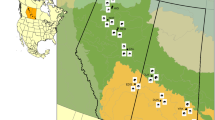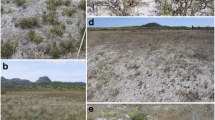Abstract
Lyman glacier in the North Cascades Mountains of Washington has a subalpine forefront characterized by a well-developed terminal moraine, inconspicuous successional moraines, fluting, and outwash. These deposits were depleted of symbiotic fungi when first exposed but colonized by them over time after exposure. Four major groups of plant species in this system are (1) mycorrhiza-independent or facultative mycotrophic, (2) dependent on arbuscular mycorrhizae (AM) (3) dependent on ericoid mycorrhiza (ERM) or ectomycorrhizae (EM), and (4) colonized by dark-septate (DS) endophytes. We hypothesized that availability of mycorrhizal propagules was related to the success of mycorrhiza-dependent plants in colonizing new substrates in naturally evolved ecosystems. To test this hypothesis roots samples of 66 plant species were examined for mycorrhizal colonization. The plants were sampled from communities at increasing distances from the glacier terminus to compare the newest communities with successively older ones. Long established, secondary successional dry meadow communities adjacent to the glacier forefront, and nearby high alpine communities were sampled for comparison. DS were common on most plant species on the forefront. Nonmycorrhizal plants predominated in the earlier successional sites, whereas the proportion of mycorrhizal plants generally increased with age of community. AM were present, mostly at low levels, and nearly absent in two sites of the forefront. ERM were present in all species of Ericaceae sampled, and EM in all species of Pinaceae and Salicaceae. Roots of plants in the long established meadow and heath communities adjacent to the forefront and the high alpine community all had one or another of the colonization types, with DS and AM predominating.



Similar content being viewed by others
References
Allen EB, Allen MF (1984) Competition between plants of different successional stages: mycorrhizae as regulators. Can J Bot 62:2625–2629
Allen EB, Chambers JC, Connor KF, Allen MF, Brown RW (1987) Natural reestablishment of mycorrhizae in disturbed alpine ecosystems. Arctic Alp Res 19:11–20
Allen MF (1991) The ecology of mycorrhizae. Cambridge University Press, Cambridge, UK
Blaschke H (1991) Multiple mycorrhizal associations of individual calcicole host plants in the alpine grass-heath zone. Mycorrhiza 1:31–34
Cázares E, Trappe JM (1990) Alpine and subalpine fungi of the Cascade Mountains. I. Hymenogaster glacialis sp. nov. Mycotaxon 38:245–249
Cázares E, Trappe JM (1994) Spore dispersal of ectomycorrhizal fungi on a glacier forefront by mammal mycophagy. Mycologia 86:507–510
Currah RS, Van Dyk M (1986) A survey of some perennial vascular plant species native to Alberta for occurrence of mycorrhizal fungi. Can Field Nat 100:330–342
Dominik T (1961) Studium o mikorhyzie. Folia For Pol Ser A 5:3–160
Freeman O (1941) The recession of Lyman Glacier, Washington. J Geol 49:764–771
Harley JL, Harley EL (1987) A check-list of mycorrhiza in the British flora. New Phytol 105[Suppl]:1–102
Hayman DS (1982) Influence of soils and fertility on activity and survival of vesicular-arbuscular mycorrhizal fungi. Phytophathology 72:1119–1125
Helm DJ, Allen EB, Trappe JM (1996) Mycorrhizal chronosequence near Exit Glacier, Alaska. Can J Bot 74:1496–1996
Jumpponen A (1999) Spatial distribution of discrete RAPD phenotypes of a root endophytic fungus, Phialocephala fortinii, at a primary successional site on a glacier forefront. New Phytol 141:333–344
Jumpponen A (2003) Soil fungal community assembly in a primary successional glacier forefront ecosystem as inferred from rDNA sequence analyses. New Phytol 158:569–578
Jumpponen A, Trappe JM (1998) Dark septate endophytes: a review of facultative biotrophic root-colonizing fungi. New Phytol 140:295–310
Jumpponen A, Mattson K, Trappe JM (1998a) Mycorrhizal functioning of Phialocephala fortinii with Pinus contorta on glacier forefront soil: interactions with soil nitrogen and organic matter. Mycorrhiza 7:261–265
Jumpponen A, Trappe JM, Cázares E (1999a) Ectomycorrhizal fungi in Lyman Lake Basin: a comparison between primary and secondary successional sites. Mycologia 91:575–582
Jumpponen A, Váre H, Mattson KG, Ohtonen R, Trappe JM (1999b) Characterization of ‘safe sites’ for pioneers in primary succession on recently deglaciated terrain. J Ecol 87:98–105
Jumpponen A, Trappe JM, Cázares E (2002) Occurrence of ectomycorrhizal fungi on the forefront of retreating Lyman Glacier (Washington, USA) in relation to time since deglaciation. Mycorrhiza 12:43–49
Kormanik PP, McGraw AC (1982) Quantification of arbuscular mycorrhizae in plant roots. In: Schenk NC (ed) Methods and principles of mycorrhizae research. American Phytopathological Society, St. Paul, Minn., pp 37–46
Kohn LM, Stasovski E (1990) The mycorrhizal status of plants at Alexandra Fiord, Ellesmere Island, Canada, a high arctic site. Mycologia 82:23–35
Lesica P, Antibus RK (1986) Mycorrhizae of alpine fell-field communities on soils derived from crystalline and calcareous parent materials. Can J Bot 64:1691–1697
Matthews JA (1979a) The vegetation of the Storbreen gletschervorfeld, Jotunheimen, Norway. I. Introduction and approaches involving classification. J Biogeogr 6:17–47
Matthews JA (1979b) The vegetation of the Storbreen gletschervorfeld, Jotunheim, Norway. II. Approaches involving ordination and general conclusions. J Biogeogr 6:133–167
Newman EI (1988) Mycorrhizal links between plants: their functioning and ecological significance. Adv Ecol Res 18:241–270
Newman EI, Reddell P (1987) The distribution of mycorrhizas among families of vascular plants. New Phytol 106:745–751
Ohtonen R, Fritze H, Penanen T, Jumpponen A, Trappe J (1999) Ecosystem properties and microbial community changes in primary succession on a glacier forefront. Oecology 119:239–246
Peyronel B (1924) Prime ricerche sulla micorize endotrofiche e sulla microflora radicola normale della fanerogame. Riv Biol 6:17–53
Phillips JM, Hayman DS (1970) Improved procedure for clearing roots and staining parasitic and arbuscular mycorrhizal fungi for rapid assessment of infection. Trans Br Mycol Soc 55:158–161
Read DJ, Francis R, Finlay RD (1985) Mycorrhizal mycelial and nutrient cycling in plant communities. In: Fitter AH, Atkinson D, Read DJ, Usher MB (eds) Ecological interactions in soil. Blackwell, Oxford, pp 193–218
Read DJ, Haselwandter K (1981) Observations on the mycorrhizal status of some alpine plant communities. New Phytol 88:341–352
Reeves FB, Wagner D, Moorman T, Kiel J (1979) The role of endomycorrhizae in revegetation practices in the semi-arid West. I. A comparison of incidence of mycorrhizae in severely disturbed vs. natural environments. Am J Bot 66:6–13
Sengupta A, Chakraborty DC, Chaudhuri S (1989) Do septate endophytes also have a mycorrhizal function for plants under stress? In: Mahadevan A, Raman N, Natarajan K (eds) Mycorrhizae of green Asia. Proceedings of First Asian Conference on Mycorrhizae, Madras, pp 169–174
Stoyke G, Currah RS (1991) Endophytic fungi from the mycorrhizae of alpine ericoid plants. Can J Bot 69:347–352
Trappe JM (1977) Selection of fungi for ectomycorrhizal inoculation in nurseries. Annu Rev Phytopathol 15:203–222
Trappe JM (1987) Phylogenetic and ecologic aspects of mycotrophy in the angiosperms from an evolutionary standpoint. In Safir G (ed) Ecophysiology of VA mycorrhizal plants. CRC, Boca Raton, Fla., pp 5–25
Trappe JM (1988) Lessons from alpine fungi. Mycologia 80:1–10
Trappe JM, Luoma D (1992) The ties that bind: fungi in ecosystems. In: Carroll G, Wicklow D (eds) The fungal community: its role in the ecosystem, 2nd edn. Dekker, New York, pp 17–27
Acknowledgements
These studies were supported by National Science Foundation Grant BSR-8717427 and the United States Forest Service, Pacific Northwest Research Station. Personnel of the Wenatchee National Forest were extremely helpful in facilitating the studies. Sid Burns, Dan Luoma, Mike Morneau and Thom O’Dell willingly helped whenever needed. The senior author thanks Consejo Nacional de Ciencia y Tecnología in México for their support.
Author information
Authors and Affiliations
Corresponding author
Rights and permissions
About this article
Cite this article
Cázares, E., Trappe, J.M. & Jumpponen, A. Mycorrhiza-plant colonization patterns on a subalpine glacier forefront as a model system of primary succession. Mycorrhiza 15, 405–416 (2005). https://doi.org/10.1007/s00572-004-0342-1
Received:
Accepted:
Published:
Issue Date:
DOI: https://doi.org/10.1007/s00572-004-0342-1




